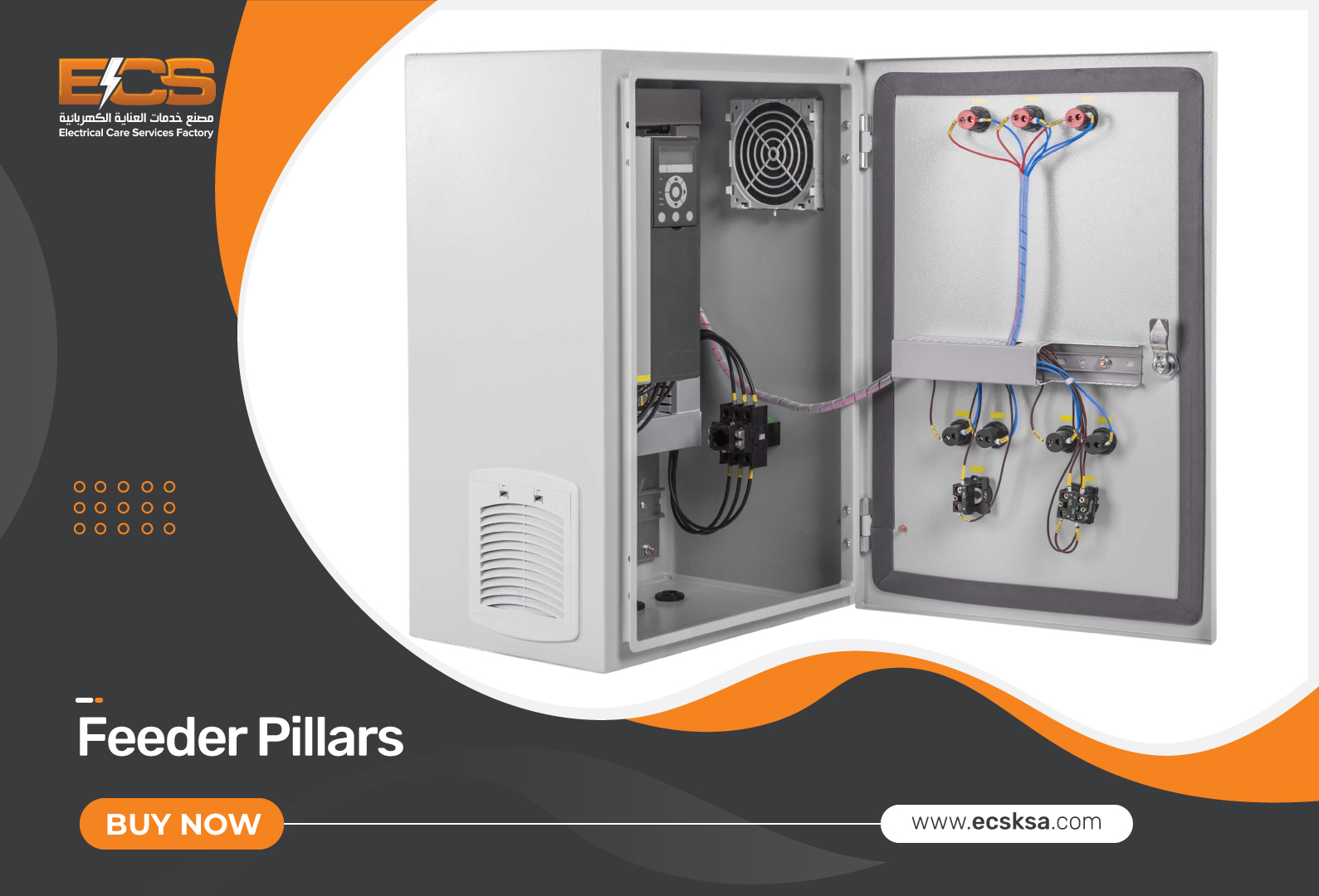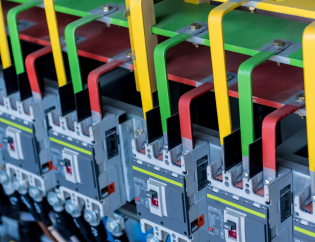In this article, you’ll learn:
- What is a feeder pillar?
- Components of feeder pillars
- Types of feeder pillars
- Features of feeder pillars
- Advantages of feeder pillars
- What should you consider before installing a feeder pillar?
So, keep reading further and grab all the knowledge.
 What is a Feeder Pillar (Power Box)?
What is a Feeder Pillar (Power Box)?
A cabinet used to hold electrical equipment is referred to as a feeder pillar (also known as a power box, distribution pillar, or feeder pillar box). In order to govern and distribute electricity to circuits downstream of the feeder pillar, feeder pillars function as a central circuit. Each circuit is protected by this configuration, which also allows for simple control.
A feeder pillar box, like a junction box, guards against individuals touching live wires and shields cables from dirt and moisture.
Controlling the electrical supply to homes in a community is done using electrical feeder pillars, which are mounted on the roadway. A cutout enclosure or other electrical enclosure that is used as a component of an underground electrical distribution system is referred to as a feeder pillar.
You might have unintentionally driven by electrical feeder poles without paying much attention. They frequently occur close to:
- Airports
- Highways
- Rail
- Retail & Leisure
- Substations
- Street Lighting
- Temporary Generator Power Hook Ups
Feeder Pillar Components
A feeder pillar resembles a large steel closet. A feeder pillar’s exterior body normally has a thickness of 2 millimeters.
Electrical feeder pillars are commonly made of steel or aluminum sheets that have been electro- or electro-galvanized. Constructions with one or two walls can be found in a 4/6/8 distribution.
These include voltmeter-equipped instrument panels, selection switches, whole-house surge protectors, service fuses, and ammeters. All types of lighting applications are compatible with the design, buildings, and construction. On top of a steel base, the entire feeder pillar unit is placed.
Features of Feeder Pillars
- With front-end jointing for all incoming connections, rear and front-mounted phase busbars make it simple to examine, maintain, and install equipment.
- For dependable performance in all outdoor situations, canopies, double doors, weatherproof coating, rubber seal gaskets, and other features are included.
- Earth busbars, neutral earth busbars, and channel base earthing are all available for safely transporting any fault current.
- Features for increased security and dependability include tamper-proof locks, robust molded DMC phase barriers spanning fuse-links and MCCB, and others.
- Through the use of appropriate cable clamps, feeder pillars are intended to handle various kinds of cable arrangements.
Types of Feeder Pillars
Feeder pillar panels are available as standard empty enclosures or as custom-made enclosures. The following are the most popular electrical feeder pillars on the market.
LV Electrical Distribution Feeder Pillars
Larger metering pillars can be designed ready to install on site or supplied as empty enclosures for construction and modification by the contractor. LV feeder pillars provide LV electrical power connections for single units to larger complex developments in the residential and commercial sectors. Smaller pillars for unmetered electricity supply include an isolation unit, cable earthing blocks, and a CET gland to suit armored cables (SWA).
With high-security vandal-resistant locks, single or three-phase pillars with individual or group switching and fuse gear options (RCBO, RCD, MCB) give a secure and dependable power supply of up to 1600 amp current.
The M&E building services, utility substations, rail, renewable energy, and hazardous area businesses receive LV pillars or freestanding panel boards. Traffic lights, CCTV, motorway communications, telecommunications, street lighting power, control, and distribution are common uses for highway pillars.
Rail Feeder Pillars
Rail feeder pillars are non-conductive and can be installed outdoors or in stations. In regions with electrified rails, it removes the danger of contact voltages. These pillars may be equipped with PADS-approved Network Rail machinery like:
- Switchgear
- DC Immune RCD
- DNO Service Hands
- Isolation Transformers
- CT Chamber & Member
- Cut-Outs & Isolators
Fortress Feeder Pillars
With pillars available in a variety of sizes (28), materials (galvanized steel, stainless steel, cast iron), and finishes (full range of RAL color options), the Fortress series of feeder pillars are manufactured with numerous novel characteristics.
Additional paint finishes (RAL and Highways G2A) are offered with anti-vandal lock variations to prevent corrosion. The electrical engineer may change the pillar backboard quickly and easily thanks to the detachable feeder pillar roof, which is also suited for future power growth of low voltage energy distribution.
Anti-condensation heaters can be installed to control enclosure ventilation.
Advantages of Feeder Pillars
Improved safety
- Operators who may be close to the pillar or performing maintenance tasks are safeguarded by the pillar’s complete insulation.
- The transformer LV input is short-circuited and earthed with the help of the top short-circuiting device.
- Operators can rapidly and safely complete EST (electrical safety testing) procedures thanks to the top and bottom voltage sockets.
Simple optimized operation
- An external emergency or maintenance power source can be connected securely via a quick-connection interface.
- For temporary installations, such as building sites, amusement parks, etc., an interim feeder is offered.
- Direct power from the pillar is used to power internal circuitry and lighting.
- A better understanding of the need for a constant power supply and the protection of people and property.
Manufacturer Warranty
Reliability is ensured by the pillar quality assurance methods, which include thorough sampling testing, traceability, and individual tests for each pillar.
Feeder Pillar Design Considerations
Installation
Professional electricians with expertise, training, and qualifications install feeder pillars. Additionally, they must adhere to any location’s health and safety lighting regulations set forth by the local municipality.
To ensure complete conformity with local authorities on electrical safety and illumination, only approved pillars from manufacturers should be installed. Each pillar that can be erected on any location, whether it’s outside or inside the property, can have a label of approval by the appropriate authorities.
The optimal locations should be away from areas where nearby customers are seriously endangered. So that the electricians may work safely and efficiently on the repair without putting customers at risk, the area should be clutter-free. If it’s not possible to provide adequate lighting for the feeder pillar, electricians can always operate while wearing headlamps.
Functionality
The purpose of feeder pillars is to ensure that the electrical fuse is kept off the property to prevent any potential electrical problems.
The feeder may look like a metal box holding coaxial and circuit wires, but it actually serves as a crucial platform for safety on any property. If the circuit box at the prescribed location needs to be upgraded, they serve to safely contain the circuitry. However, a sturdy feeder pillar alone won’t guarantee that everything is safe; you must always make sure that you’re using the greatest coaxial cable money can buy (as they are not very expensive).
An expert electrician will advise selecting the proper feeder box to house all of the circuitry for more effective lighting. The proper feeder aids in controlling a sizable power supply that safely passes through the wires, with designated fuses for quick identification. If you need assistance with this, a reliable electrical circuit tracer will help you locate wires behind walls and swiftly identify breakers and fuses.
Simple Minded Operation
The connection interface on feeder pillars is straightforward, enabling easy attachment of a maintenance or emergency power source. To maintain the tightening torque, the feeders are equipped with terminals that feature self-snapping fuse screws.
The pillar serves as a direct source of electricity for interior circuits and illumination. As a result, depending on their position, electricians can use them with ease and with simple operation.
Design and Robustness
An excellent feeder pillar should be streamlined and smooth in appearance. By using big thermostat insulated fittings, it ought to have increased user safety. Because of its stiffness and the additional robustness that its insulating material offers, it can withstand strong winds and other trying circumstances. If you need to measure the insulating resistance, be sure to use one of the best testers available.
Conclusion
Now, you know everything about feeder pillars that’ll help you to choose the best one for your large electrical distribution system. So, don’t risk power failures – upgrade to ECSKSA’s top-quality feeder pillars today
Check out our product pages to order feeder pillars for your operations.
Frequently Asked Questions
Q1: What does a feeder pillar do?
A feeder pillar box, like a junction box, guards against individuals touching live wires and shields cables from dirt and moisture.
Q2. How many types of feeder pillars are there?
There are mainly three types of feeder pillars.
- LV feeder pillars
- Rail feeder pillars
- Fortress feeder pillars
Do you have a question in your mind? If so, make sure to fill out the form below!


